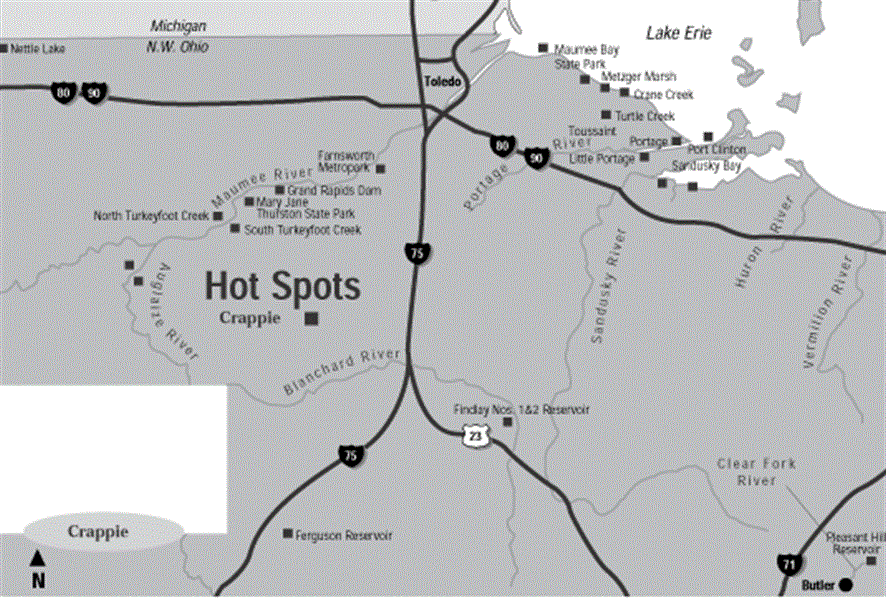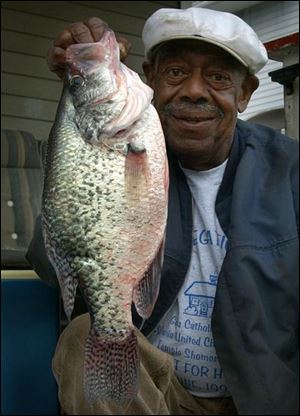
Following the fish: Crappie season opens on a big note
5/14/2004

George Taylor, of Toledo, hefts his crappie-of-a-lifetime a 3-pounder.
If crappie-fishing season in Ohio needed an opening day, it may have been last Monday evening when Toledo angler George Taylor landed a fish of trophy dimensions.
It was a black crappie measuring 173/4 inches and weighing 2.97 pounds. A whopper.
“When he opened that cooler, my jaw just dropped,” said Jan Lowry, who with her husband Gary operates Maumee Valley Bait and Tackle in Maumee. Taylor had taken in the big crappie for official weighing and measuring.
“I ve never seen a crappie that big,” said Jan?? Lowry. “I ve got one that is 21/4 pounds and it looks like a baby. That s an impressive fish.” Indeed, it is so impressive that the Lowrys offered to have the fish mounted and displayed, complete with Taylor s name, in the shop.

Taylor s fish is not a state record - that title belongs to a 41/2–pounder, 181/8 inches long, taken in 1981 from a private lake near Wooster. But it easily qualifies for Fish Ohio award status, the crappie minimum for recognition being a mere 13 inches.
Taylor said he was fishing Monday evening above the Grand Rapids Dam, using a minnow fished under a bobber.
“He hit real slow and took the bobber under the water. I set the hook while the bobber was on the way back up.” The fisherman added that the big panfish put up a “fairly good fight. I caught him in the first five minutes I was there.”
At 66, Taylor has been fishing for at least 50 years and says it is not only the biggest crappie he ever has caught, “it s the biggest one I ve ever seen.” Mostly, though, he found the action slow and called it a night after an hour.
“We ve seen them that big and we caught one that size in our survey nets this spring at Clear Fork Reservoir near Mansfield,” said Larry Goedde, fish-management supervisor for Ohio Wildlife District 2. “Still, it s a heck of a fish. It s kind of neat that this one came out of a public area, the Maumee River.”
The state s record white crappie also was taken from a private pond, this near Zanesville, in 1995. It was 3.9 pounds and stretched 181/2 inches. Fish in private waters usually are less pressured and have more time to grow older and bigger, and sometimes they have more forage base and less competition. All of which helps make Taylor s public-water crappie so notable.
While weather patterns of late have been erratic, in turn making fish activity erratic, Goedde noted, “This would be about the right time for crappie.”
The easiest way to catch them, he explained, is to fish around brush in shallow areas - usually along banks and shorelines where brush or some structure exists - when the fish have moved inshore and congregated to spawn.
Of all the fishing tactics, Goedde likes to fish minnows in the shallows, much as Taylor did. One of the tricks is to keep moving, quietly hunting, until a school is found. Get close but not too close. Spring crappies, usually found in water just one to five feet deep, can be jumpy. Veteran anglers will slide into 10- to 15-foot water if no fish are found in the shallows.
“There are areas where a lot of people don t go,” added Goedde about favored crappie holes. A lot of smaller streams and tributaries in the region hold crappies and often are all but ignored. The biologist pointed, for example, to the Blanchard River in Hancock and Putnam counties as a sleeper of a crappie stream. Other top crappie creeks run into the small feeder streams that flow into Sandusky Bay, not to mention the bay itself, Goedde said.
“Crappie are harder to locate in the upground reservoirs, except in shoreline areas this time of year.” Seek any shoreline structure to find crappies in the upgrounds. Findlay No. 1 and No. 2 reservoirs, for example, have sunken Christmas trees along the access dike that separates the two reservoirs.
The Ohio Division of Wildlife names Findlay No. 2, southeast of Findlay in Hancock County, Nettle Lake in Williams County, and Pleasant Hill Reservoir, east of Mansfield in Richland County, among top crappie picks for its northwest district in 2004.
The Maumee River around Mary Jane Thurston State Park near Grand Rapids and further downstream at Farnsworth Metropark s boat ramp at Waterville also is rated as worth a try. Other areas to try are the lower Auglaize River near its entry to the Maumee at Defiance, and North Turkeyfoot Creek and South Turkeyfoot Creek, on the Maumee between Defiance and Grand Rapids. Other good areas include the inland ponds at Maumee Bay State Park, the nearby Cooley and Ward canals and the lower Portage River around Oak Harbor to Port Clinton. East Harbor State Park near Lakeside on Marblehead peninsula also is high on the crappie list.
White crappie tend to tolerate silty and turbid water better than black crappies, which prefer clearer water. White crappies have five to 10 vertical bands on their sides and backs, and black crappies have deeper bodies with dusky or dark blotches. White crappies have five or six dorsal spines and black crappies have seven or eight.
Light or ultralight spinning tackle is fine, using bobbers and minnows, or small jigs and minnows, jigs and Twister tails or small Mepps spinners and the like in chrome or white.
Contact Steve Pollick at: spollick@theblade.com or 419-724-6068